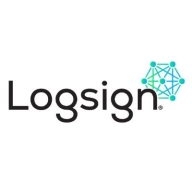

Logsign Next-Gen SIEM and Microsoft Sentinel are both robust SIEM solutions with distinct strengths. Microsoft Sentinel excels in feature richness, making it a valuable investment despite its higher cost.
Features: Logsign Next-Gen SIEM offers automation, customizable dashboards, and user-friendliness. Microsoft Sentinel offers integration capabilities, advanced analytics, and deeper functionality.
Room for Improvement: Logsign Next-Gen SIEM needs improvement in reporting features, scalability, and feature expansion. Microsoft Sentinel needs better documentation, improved incident management, and usability improvements.
Ease of Deployment and Customer Service: Logsign Next-Gen SIEM is noted for its swift deployment and responsive support team. Microsoft Sentinel’s deployment is also straightforward but can be more complex due to its broad capabilities. Customer support for Logsign is rated higher, while Sentinel's larger user base provides extensive community support.
Pricing and ROI: Logsign Next-Gen SIEM is considered cost-effective with a transparent pricing model and substantial value at a lower cost. Microsoft Sentinel, though pricier, justifies the investment through its extensive feature set and integration potential, providing strong long-term returns.
| Product | Market Share (%) |
|---|---|
| Microsoft Sentinel | 6.2% |
| Logsign Next-Gen SIEM | 0.5% |
| Other | 93.3% |


| Company Size | Count |
|---|---|
| Small Business | 37 |
| Midsize Enterprise | 20 |
| Large Enterprise | 41 |
Logsign delivers automation-driven cyber security solutions and are committed to providing the smartest, easiest-to-use and most affordable cybersecurity detection and response solutions and value-added services. Logsign Next-Gen SIEM is an enterprise-grade SIEM, inline with our promise, it's easy-to-deploy, easy-to-use and affordable unlike the other enterprise-grade SIEM softwares.
Microsoft Sentinel is a scalable, cloud-native, security information event management (SIEM) and security orchestration automated response (SOAR) solution that lets you see and stop threats before they cause harm. Microsoft Sentinel delivers intelligent security analytics and threat intelligence across the enterprise, providing a single solution for alert detection, threat visibility, proactive hunting, and threat response. Eliminate security infrastructure setup and maintenance, and elastically scale to meet your security needs—while reducing IT costs. With Microsoft Sentinel, you can:
- Collect data at cloud scale—across all users, devices, applications, and infrastructure, both on-premises and in multiple clouds
- Detect previously uncovered threats and minimize false positives using analytics and unparalleled threat intelligence from Microsoft
- Investigate threats with AI and hunt suspicious activities at scale, tapping into decades of cybersecurity work at Microsoft
- Respond to incidents rapidly with built-in orchestration and automation of common tasks
To learn more about our solution, ask questions, and share feedback, join our Microsoft Security, Compliance and Identity Community.
We monitor all Security Information and Event Management (SIEM) reviews to prevent fraudulent reviews and keep review quality high. We do not post reviews by company employees or direct competitors. We validate each review for authenticity via cross-reference with LinkedIn, and personal follow-up with the reviewer when necessary.